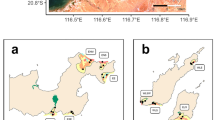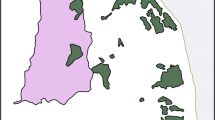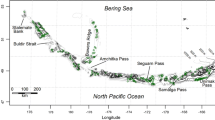Abstract
Hard structural complexity is widely recognised as important for assessing fish habitat quality, but our understanding of the importance of soft habitat microstructure for temperate marine fishes is less developed. We used best-subsets modelling of underwater surveys in sponge, soft coral, and macroalgae mesohabitats within a temperate estuary to assess what measures of soft habitat structure best predicted differences in wrasse (family: Labridae) fish community composition. We found that significant differences in the labrid fish community among and within mesohabitat types were best explained by a combination of percent canopy cover and soft canopy height, with increased canopy height being correlated with increased fish abundance and species richness. Sponge and macroalgae mesohabitats emerged as particularly important, but vulnerable habitats for a diversity of fishes unique to these mesohabitat types. Ultimately, mesohabitats with high percent canopy cover and height appear to be particularly valuable for supporting estuarine fish communities. Due to this importance, and the potential for decadal-scale recovery times within sponge canopies, we suggest patches with high-quality canopy structure warrant special protection from local threats, such as anchor and fishing damage.






Similar content being viewed by others
References
Anderson MJ, Millar RB (2004) Spatial variation and effects of habitat on temperate reef fish assemblages in northeastern New Zealand. J Exp Mar Bio Ecol 305:191–221. doi:10.1016/j.jembe.2003.12.011
Anderson MJ, Gorley RN, Clarke KR (2008) PERMANOVA + for PRIMER: guide to software and statistical methods. PRIMER-E Ltd, Plymouth
Ayling AL (1983) Growth and regeneration rates in thinly encrusting Demospongiae from temperate waters. Biol Bull 165:343–352. doi:10.2307/1541200
Bell JJ (2008) The functional roles of marine sponges. Estuar Coast Shelf Sci 79:341–353. doi:10.1016/j.ecss.2008.05.002
Boury-Esnault N, Rutzler K (1997) Thesaurus of sponge morphology. Smithsonian Instituion Press, Washington, D. C
Burnham KP, Anderson MJ (2002) Model selection and multi-model inference: a practical information-theoretic approach, 2nd edn. Springer, New York, USA
Cárdenas CA, Davy SK, Bell JJ (2016) Influence of canopy-forming algae on temperate sponge assemblages. J Mar Biol Assoc United Kingdom 96:351–362. doi:10.1017/S0025315414002057
Chiappone M, Dienes H, Swanson DW, Miller SL (2005) Impacts of lost fishing gear on coral reef sessile invertebrates in the Florida Keys National Marine Sanctuary. Biol Conserv 121:221–230. doi:10.1016/j.biocon.2004.04.023
Choat JH, Ayling AM (1987) The relationship between habitat structure and fish faunas on New Zealand reefs. 110:257–284. doi:10.1016/0022-0981(87)90005-0
Clarke KR, Gorley RN (2006) PRIMER v6: user manual. PRIMER-E, Plymouth
Coleman MA, Kelaher BP, Steinberg PD, Millar AJK (2008) Absence of a large brown macroalga on urbanized rocky reefs around Sydney, Australia, and evidence for historical decline. J Phycol 44:897–901. doi:10.1111/j.1529-8817.2008.00541.x
Curley BG, Kingsford MJ, Gillanders BM (2002) Spatial and habitat-related patterns of temperate reef assemblages: implications for the design of Marine Protected Areas. Mar Freshw Res 53:1197–1210
Davis TR, Harasti D, Smith SDA (2015a) Developing a habitat classification typology for subtidal habitats in a temperate estuary in New South Wales, Australia
Davis TR, Harasti D, Smith SDA (2015b) Extension of Dendronephthya australis soft corals in tidal current flows. Mar Biol 162:2155–2159. doi:10.1007/s00227-015-2732-7
Demers MCA, Davis AR, Knott NA (2013) A comparison of the impact of “seagrass-friendly” boat mooring systems on Posidonia australis. Mar Environ Res 83:54–62. doi:10.1016/j.marenvres.2012.10.010
Ettinger-Epstein P, Kingsford MJ (2008) Effects of the El Nino southern oscillation on Turbo torquatus (Gastropoda) and their kelp habitat. Austral Ecol 33:594–606. doi:10.1111/j.1442-9993.2007.01824.x
Freese L, Auster PJ, Heifetz J, Wing BL (1999) Effects of trawling on seafloor habitat and associated invertebrate taxa in the Gulf of Alaska. Mar Ecol Prog Ser 182:119–126. doi:10.3354/meps182119
Fulton CJ, Bellwood DR (2002) Patterns of foraging in labrid fishes. Mar Ecol Prog Ser 226:135–142
Fulton CJ, Depczynski M, Holmes TH, Noble MM, Radford B, Wernberg T, Wilson SK (2014) Sea temperature shapes seasonal fluctuations in seaweed biomass within the Ningaloo coral reef ecosystem. Limnol Oceanogr 59:156–166. doi:10.4319/lo.2014.59.01.0156
Fulton CJ, Noble MN, Radford B, Gallen C, Harasti D (2016) Microhabitat selectivity underpins regional indicators of fish abundance and replenishment. Ecol Indic 70:222–231. doi:10.1016/j.ecolind.2016.06.032
Gillanders BM, Kingsford MJ (1998) Influence of habitat on abundance and size structure of a large temperate-reef fish, Achoerodus viridis (Pisces: Labridae). 132:503–514. doi:10.1007/s002270050416
Graham NAJ, Nash KL (2013) The importance of structural complexity in coral reef ecosystems. Coral Reefs 32:315–326. doi:10.1007/s00338-012-0984-y
Gratwicke B, Speight MR (2005) The relationship between fish species richness, abundance and habitat complexity in a range of shallow tropical marine habitats. J Fish Biol 66:650–667. doi:10.1111/j.1095-8649.2005.00629.x
Harasti D (2016) Declining seahorse populations linked to loss of essential marine habitats. Mar Ecol Prog Ser 546:173–181. doi:10.3354/meps11619
Harasti D, Martin-Smith K, Gladstone W (2014) Ontogenetic and sex-based differences in habitat preferences and site fidelity of White’s seahorse Hippocampus whitei. J Fish Biol 85:1413–1428. doi:10.1111/jfb.12492
Hardin G (1960) The competitive exclusion principle. Science (80-) 131:1292–1297. doi:10.1126/science.131.3409.1292
Holbrook SJ, Carr MH, Schmitt RJ, Coyer JA (1990a) Effect of giant kelp on local abundance of reef fishes: the importance of ontogenetic resource requirements. Bull Mar Sci 47:104–114
Holbrook SJ, Schmitt RJ, Ambrose RF (1990b) Biogenic habitat structure and characteristics of temperate reef fish assemblages. Aust J Ecol 15:489–503
Horinouchi M (2007) Review of the effects of within-patch scale structural complexity on seagrass fishes. J Exp Mar Bio Ecol 350:111–129. doi:10.1016/j.jembe.2007.06.015
Hortal J, Triantis KA, Meiri S, Thebault E, Sfenthourakis S (2009) Island species richness increases with habitat diversity. Am Nat 174:E205–E217. doi:10.1086/645085
Kerry JT, Bellwood DR (2015a) Do tabular corals constitute keystone structures for fishes on coral reefs? Coral Reefs 34:41–50. doi:10.1007/s00338-014-1232-4
Kerry JT, Bellwood DR (2015b) The functional role of tabular structures for large reef fishes: avoiding predators or solar irradiance? Coral Reefs 693–702. doi:10.1007/s00338-015-1275-1
Kramer MJ, Bellwood O, Fulton CJ, Bellwood DR (2015) Refining the invertivore: diversity and specialisation in fish predation on coral reef crustaceans. Mar Biol 162:1779–1786. doi:10.1007/s00227-015-2710-0
Kulbicki M, Guillemot N, Amand M (2005) A general approach to length-weight relationships for New Caledonian lagoon fishes. Cybium 29:235–252.
Kutti T, Fosså J, Bergstad O (2015) Influence of structurally complex benthic habitats on fish distribution. Mar Ecol Prog Ser 520:175–190. doi:10.3354/meps11047
La Mesa G, Molinari A, Gambaccini S, Tunesi L (2011) Spatial pattern of coastal fish assemblages in different habitats in North-western Mediterranean. Mar Ecol 32:104–114. doi:10.1111/j.1439-0485.2010.00404.x
Larkum AWD (1986) A Study of growth and primary production in Ecklonia radiata (C. Ag.) J. Agardh (Laminariales) at a sheltered site in Port Jackson, New South Wales. J Exp Mar Bio Ecol 96:177–190
Lecchini D, Galzin R (2005) Spatial repartition and ontogenetic shifts in habitat use by coral reef fishes (Moorea, French Polynesia). 147:47–58. doi:10.1007/s00227-004-1543-z
Leys SP, Lauzon NRJ (1998) Hexactinellid sponge ecology: Growth rates and seasonality in deep water sponges. J Exp Mar Bio Ecol 230:111–129. doi:10.1016/S0022-0981(98)00088-4
Lim I, Wilson SK, Holmes TH, Noble MM, Fulton CJ (2016) Specialisation within a shifting habitat mosaic underpins the seasonal abundance of a tropical fish. Ecosphere 7:1–32. doi:10.1002/ecs2.1212
Mabin C, Gribben P, Fischer A, Wright J (2013) Variation in the morphology, reproduction and development of the habitat-forming kelp Ecklonia radiata with changing temperature and nutrients. Mar Ecol Prog Ser 483:117–131. doi:10.3354/meps10261
Malcolm HA, Smith SDA (2010) Objective selection of surrogate families to describe reef fish assemblages in a subtropical marine park. Biodivers Conserv 19:3611–3618. doi:10.1007/s10531-010-9913-y
Morton JK, Gladstone W (2011) Spatial, temporal and ontogenetic variation in the association of fishes (family Labridae) with rocky-reef habitats. Mar Freshw Res 62:870–884. doi:10.1071/MF10315
Morton JK, Platell ME, Gladstone W (2008) Differences in feeding ecology among three co-occurring species of wrasse (Teleostei: Labridae) on rocky reefs of temperate Australia. Mar Biol 154:577–592. doi:10.1007/s00227-008-0951-x
Mulder CPH, Bazeley-White E, Dimitrakopoulos PG, Hector A, Scherer-Lorenzen M, Schmid B (2004) Species evenness and productivity in experimental plant communities. Oikos 107:50–63. doi:10.1111/j.0030-1299.2004.13110.x
Munday PL (2004) Habitat loss, resource specialization, and extinction on coral reefs. Glob Chang Biol 10:1642–1647. doi:10.1111/j.1365-2486.2004.00839.x
Munday PL, Jones GP, Caley MJ (1997) Habitat specialisation and the distribution and abundance of coral-dwelling gobies. Mar Ecol Prog Ser 152:227–239. doi:10.3354/meps152227
Nagelkerken I, Roberts CM, Van der Velde G, Gorissen MW, Meijer GJ, Van’t Hof T, Den Hartog C (2002) How important are mangroves and seagrass beds for coral-reef fish? The nursery hypothesis tested on an island scale. 244:299–305
Nash KL, Graham NAJ, Wilson SK, Bellwood DR (2012) Cross-scale Habitat structure drives fish body size distributions on coral reefs. Ecosystems 16:478–490. doi:10.1007/s10021-012-9625-0
Noble MM, van Laake G, Berumen M, Fulton CJ (2013) Community change within a Caribbean coral reef marine protected area following two decades of local management. PLoS One 8:e54069
Perez-Matus A, Shima JS (2010) Disentangling the effects of macroalgae on the abundance of temperate reef fishes. J Exp Mar Bio Ecol 388:1–10. doi:10.1016/j.jembe.2010.03.013
Poore AGB, Watson MJ, de Nys R, Lowry JK, Steinberg PD (2000) Patterns of host use among alga- and sponge- associated amphipods. Mar Ecol Prog Ser 208:183–196. doi:10.3354/meps208183
Poulos DE, Harasti D, Gallen C, Booth DJ (2013) Biodiversity value of a geographically restricted soft coral species within a temperate estuary. Aquat Conserv Mar Freshw Ecosyst 23:838–849. doi:10.1002/aqc.2362
Poulos DE, Gallen C, Davis T, Booth DJ, Harasti D (2015) Distribution and spatial modelling of a soft coral habitat in the Port Stephens—Great Lakes Marine Park: implications for management
Pratchett MS, Coker DJ, Jones GP, Munday PL (2012) Specialization in habitat use by coral reef damselfishes and their susceptibility to habitat loss. Ecol Evol 2:2168–2180. doi:10.1002/ece3.321
Shepard S, Edgar GJ (2013) Ecology of Australian temperate reefs: the unique south. CSIRO Publishing, Collingwood
Syms C, Jones GP (2000) Disturbance, habitat structure, and the dynamics of a coral-reef fish community. Ecology 81:2714–2729
Taylor RB (1998) Density, biomass and productivity of animals in four subtidal rocky reef habitats: the importance of small mobile invertebrates. Mar Ecol Prog Ser 172:37–51. doi:10.3354/meps172037
Tuya F, Wernberg T, Thomsen MS (2009) Habitat structure affect abundances of labrid fishes across temperate reefs in south-western Australia. Environ Biol Fishes 86:311–319. doi:10.1007/s10641-009-9520-5
Vergés A, Steinberg PD, Hay ME, Poore AGB, Campbell AH, Ballesteros E, Heck Jr KL, Booth DJ, Coleman MA, Feary DA, Figueira W, Langlois T, Marzinelli EM, Mizerek T, Mumby PJ, Nakamura Y, Roughan M, van Sebille E, Sen Gupta A, Smale DA, Tomas F, Wernberg T, Wilson SK (2014) The tropicalization of temperate marine ecosystems: climate-mediated changes in herbivory and community phase shifts The tropicalization of temperate marine ecosystems: climate-mediated changes in herbivory and community phase shifts. Proc R Soc B 281:1–10. doi:10.1098/rspb.2014.0846
Wellenreuther M, Syms C, Clements KD (2008) Consistent spatial patterns across biogeographic gradients in temperate reef fishes. Ecography (Cop) 31:84–94. doi:10.1111/j.2007.0906-7590.05270.x
Wernberg T, Bennett S, Babcock RC, de Bettignies T, Cure K, Depczynski M, Dufois F, Fromont F, Fulton CJ, Hovey RK, Harvey ES, Holmes TH, Kendrick GA, Radford B, Santana-Garcon J, Saunders BJ, Smale DA, Thomsen MS, Tuckett CA, Tuya F, Vanderklift MA, Wilson SK (2016a) Climate-driven regime shift of a temperate marine ecosystem. Science 353:169–172. doi:10.1126/science.aad8745
Wernberg T, de Bettignies T, Joy BA, Finnegan PM (2016b) Physiological responses of habitat-forming seaweeds to increasing temperatures. Limnol Oceanogr. doi:10.1002/lno.10362
Wilson SK, Graham NAJ, Pratchett MS, Jones GP, Polunin NVC (2006) Multiple disturbances and the global degradation of coral reefs: Are reef fishes at risk or resilient? Glob Chang Biol 12:2220–2234. doi:10.1111/j.1365-2486.2006.01252.x
Wilson SK, Graham NAJ, Polunin NVC (2007) Appraisal of visual assessments of habitat complexity and benthic composition on coral reefs. Mar Biol 151:1069–1076. doi:10.1007/s00227-006-0538-3
Wilson SK, Burgess SC, Cheal AJ, Emslie M, Fisher R, Miller I, Polunin NVC, Sweatman HPA (2008) Habitat utilization by coral reef fish: implications for specialists vs. generalists in a changing environment. J Anim Ecol 77:220–228. doi:10.1111/j.1365-2656.2007.01341.x
Wilson SK, Depczynski M, Fisher R, Holmes TH, O’Leary RA, Tinkler P (2010) Habitat associations of juvenile fish at Ningaloo Reef, Western Australia: the importance of coral and algae. PLoS One 5:e15185. doi:10.1371/journal.pone.0015185
Wilson SK, Fulton CJ, Depczynski M, Holmes TH, Noble MM, Radford B, Tinkler P (2014) Seasonal changes in habitat structure underpin shifts in macroalgae-associated tropical fish communities. Mar Biol 161:2597–2607. doi:10.1007/s00227-014-2531-6
Acknowledgements
We thank Martial Depczynski and Shaun Wilson for helpful discussions, two anonymous peer reviewers for constructive feedback on an earlier draft of the manuscript, and the Australian National University and New South Wales Department of Primary Industries for funding.
Author information
Authors and Affiliations
Corresponding author
Ethics declarations
This work was conducted with the approval of NSW Department of Primary Industries Animal Care and Ethics Committee permit 12/20.
Conflict of interest
All authors declare that they have no conflict of interest.
Additional information
Responsible Editor: G. H. Engelhard.
Reviewed by J. Morton and an undisclosed expert.
Electronic supplementary material
Below is the link to the electronic supplementary material.
Rights and permissions
About this article
Cite this article
van Lier, J.R., Harasti, D., Laird, R. et al. Importance of soft canopy structure for labrid fish communities in estuarine mesohabitats. Mar Biol 164, 45 (2017). https://doi.org/10.1007/s00227-017-3068-2
Received:
Accepted:
Published:
DOI: https://doi.org/10.1007/s00227-017-3068-2




